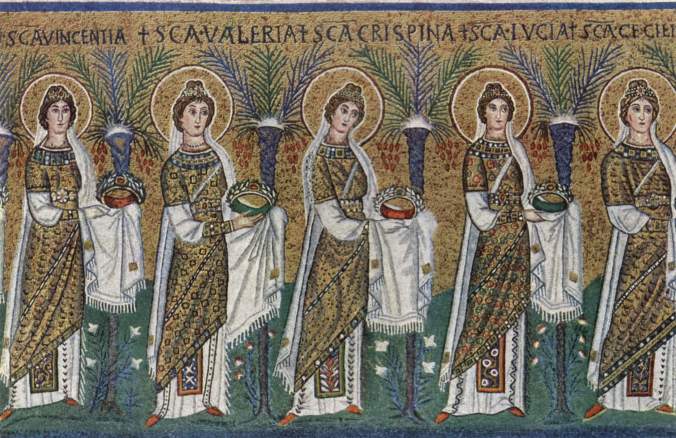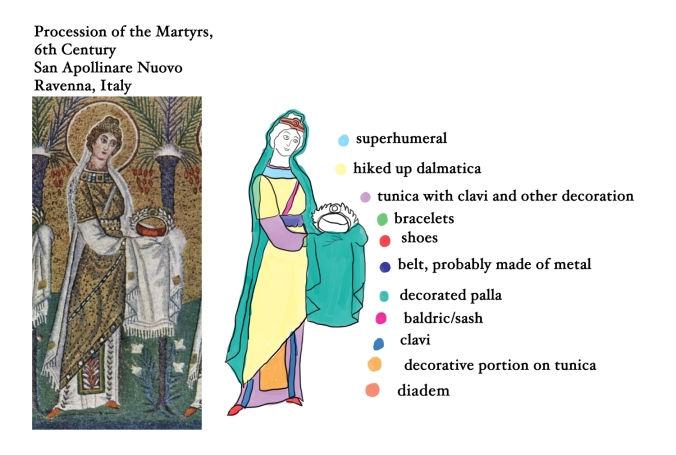 The Procession of the Virgin Martyrs is an incredible piece of art from 6th century Ravenna (see also the mosaic of Theodora with Attendants, also located in Ravenna and completed during the reign of Justinian and Theodora). Created with thousands of tesserae (or glass or stone tiles), this piece of artwork completed during the reign of Justinian and Theodora gives a glimpse of what the nobility wore.
The Procession of the Virgin Martyrs is an incredible piece of art from 6th century Ravenna (see also the mosaic of Theodora with Attendants, also located in Ravenna and completed during the reign of Justinian and Theodora). Created with thousands of tesserae (or glass or stone tiles), this piece of artwork completed during the reign of Justinian and Theodora gives a glimpse of what the nobility wore.
The downside: it’s a two dimensional piece of work. Masterfully created folds definitely look like folds, but cannot be flipped up or manipulated to really get a good look at them. On the other hand, we have some textiles from Egypt (sometimes called Coptic textiles, but as the Copts are an ethnoreligious group that’s still in existence today, I prefer to not use this term, instead, I’ll use Byzantine-Egyptian textiles) that can provide some clues.
The first step in demystifing the Virgin Martyrs’ clothing was starting at the base level and identifying what they’re wearing. I picked one of the women and traced around her, and then got to work colour-coding what she’s wearing.
 As you can see, there’s a bunch of layers. When I first started looking at this particular piece, I wondered if the dalmatica was wrapped around the body. It is not. (I tried and I actually fell over when I tried to walk!) Based on the folds shown in the mosaic, the dalmatica is hiked up and tucked through the belt, as if our martyr was off to work. The white baldric looks as it’s part of the underdress, but it is a baldric (again, going off contextual clues from the folds and the fact that there is a martyr (or two) who do not have the baldrics. The veil/palla is far more like what was seen in Imperial Rome, especially looking at her hair and diadem, however, given that another similar piece from around the same time was found within the Empire, without the palla, we can compare them fairly safely.
As you can see, there’s a bunch of layers. When I first started looking at this particular piece, I wondered if the dalmatica was wrapped around the body. It is not. (I tried and I actually fell over when I tried to walk!) Based on the folds shown in the mosaic, the dalmatica is hiked up and tucked through the belt, as if our martyr was off to work. The white baldric looks as it’s part of the underdress, but it is a baldric (again, going off contextual clues from the folds and the fact that there is a martyr (or two) who do not have the baldrics. The veil/palla is far more like what was seen in Imperial Rome, especially looking at her hair and diadem, however, given that another similar piece from around the same time was found within the Empire, without the palla, we can compare them fairly safely.
So, let’s look at what we do know, based on items that we have found.
Again, Egyptian tunics from the time are not going to be as fancy as what was worn at court in Constantinople, however, we can use them to get an idea. This particular tunica comes close to the tunicae that the virgins are wearing (again, note the geometric construction and just how wide it is! The belt is a necessity). The decorative panel could have been woven in, much like the rest of the trim, though this is problematic based on the folds of fabric just under the panel. It could also be simply artistic, as we don’t see this item in anything else from this time period. We do see later pieces that have palliums, however, those are on the outside of the delmatikion, not in between.
As for the belt: metal belt findings were worn by men (as a way to keep pants up), however, there’s not much out there that has been worn by women. Yet, we see the virgins all wear belts. The Walters has a metal belt with coins dating from the 4th c, delicate, with chains connecting the coins together. It is similar to the belts of the virgins, as they are decorated with gems and pearls, but unlike the belts of the virgins, the coins stick out quite a bit.
For shoes, there’s quite a bit out there. At the Athens Byzantine and Christian Museum, a display has three pairs of leather slippers (all red and all gilt), all dating from the 5th to the 8th centuries. A particular pair bears a strong resemblance to the shoes the virgins are wearing – pointed toes, as we can see in the mosaic.
Lastly, the superhumeral and the cuffs/bracelets. We have examples of the superhumeral in art, but no surviving pieces. Bracelets exist (the Ferrell collection has a stunningly gorgeous one), however, these appear to be cuffs on a gown pushed up as if for work.
It’s all searching, researching, and doing it over and over. And just when you think you’ve got it figured out, ideas change. For now, this is good to start with and with breaking the ideas apart and starting small.
If they are martyrs it may be that they are wearing the long scapular common to many religious groups at that time. This was a long narrow piece of fabric, often plain, but could be decorated as well, that was either one piece with an opening for the head, or it was two pieces held at the shoulders with narrow straps. The large scapular is so ubiquitous from early times that eventually smaller and smaller versions were made for the laity to wear as the laity often adopted it to show their deep devotion to the faith, but the original would have looked like what the martyrs are wearing in this mosaic and some religious orders wear it still.
LikeLike
Do you have citations for this? I would be interested in seeing them.
LikeLiked by 1 person
You mean for the history of the Scapular and its use? Somewhere, packed up likely. It was something I read up on during my Masters. I’ll see what I can find. Hubby is renovating and so much is in unmarked containers…. ping me again if you don’t hear back by the end of the week.
LikeLike
Short modern reference to the history can be found online, places like here: https://www.ewtn.com/expert/answers/brown_scapular.htm
LikeLike
This is a biased source and not one I would use for the history of the scapular.
LikeLike
Another brief run-down. But not the academic stuff you are asking for– but readers might find it useful: http://www.newadvent.org/cathen/13508b.htm
LikeLike
Again, this is a biased source and not academic. If one wants to know what a scapular is, or wants to know what they’re currently used for, this is a good place to send them. However, for this, it does not make sense to make that jump in logic between modern and medieval. While Benedict’s rule was written in the 7th century, and he talks about the use of scapulars, this article does not show, from an academic standpoint, if the martyrs here from the 6th century are using them. Additionally, monasticism at this point is less religious order and more people living in religious life together – less of a rules according to a leader like Benedict of Nursia.
LikeLike
This online article, still not the academic stuff you wanted, but might be interesting for readers: http://www.medieval-life-and-times.info/medieval-clothing/medieval-monks-clothing.htm
LikeLike
This is a terrible website that doesn’t cite sources! Please, if you’re going to use websites as sources, please ensure that they’re citing sources. There is a reason I asked for academic sources – checking their sources is a good thing, and being able to detect bias is also a good thing. Look, EWTN is fine if one is wanting to find out more about being a Catholic. Finding out where prayer beads/rosaries started from? Less good.
LikeLike
Yeah, this is where I need some really hard facts. At this point in history, there’s less about religious orders and more monasticism, sans the orders. Benedict’s Rule wasn’t until the 7th century. This is a 6th c piece of art.
I have a hard time believing these are scapulars as you’re detailing. Yes, Benedict’s Rule speaks about this, but again, what we know of scapulars now does not fit this narrative.
I do not agree with your posts of websites here.
LikeLike
Your interest in this topic really came through with this post. Even though this is a long way both in space and time from my Burgundian persona I enjoyed reading it. Thanks.
LikeLike
Thank you!
LikeLike
Pingback: Super-duper-humerals | konstantia kaloethina